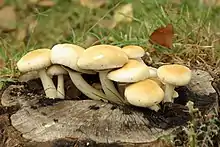Cyclocybe aegerita
Cyclocybe aegerita, also called Agrocybe cylindracea, Agrocybe aegerita or Pholiota aegerita,[1] is a mushroom in the genus Cyclocybe which is commonly known as the poplar mushroom,[1] chestnut mushroom, or velvet pioppini (Chinese: cha shu gu, 茶树菇, literally "Tea Tree Mushroom"[2]). In Japan, it is called Yanagi-matsutake (Japanese:柳松茸).[3]
| Cyclocybe aegerita | |
|---|---|
 | |
| Growing on a poplar stump in Girona, Spain | |
| Scientific classification | |
| Kingdom: | Fungi |
| Division: | Basidiomycota |
| Class: | Agaricomycetes |
| Order: | Agaricales |
| Family: | Strophariaceae |
| Genus: | Cyclocybe |
| Species: | C. aegerita |
| Binomial name | |
| Cyclocybe aegerita (V. Brig.) Vizzini 2014 | |
| Cyclocybe aegerita | |
|---|---|
float | |
| gills on hymenium | |
| spore print is brown | |
| edibility: choice but not recommended | |
Description
It belongs to the white rot fungi and is a medium-sized agaric having a very open and convex cap, almost flat, with a diameter of 3–10 centimetres (1–4 inches). Underneath, it has numerous whitish radial plates adherent to the foot, later turning to a brownish-grey colour, and light elliptic spores of 8–11 by 5–7 micrometres. The white fibre foot is generally curved, having a membranous ring on the top part which promptly turns to tobacco colour due to the falling spores.[1] When very young, its colour may be reddish-brown and later turn to a light brown colour, more ochre towards the centre, whiter around its border. It grows in tufts on logs and holes in poplars, and other large-leaved trees.[1]
Edibility
The mushroom is cultivated commercially and it is typical of both South European and Chinese cooking.
In Asia, it is used fresh and rehydrated in various dishes, including stir-fry, soup, stew, and hot pot.[2] It has a soft cap and a harder stem. Picking specimens from the wild is not recommended due to the difficulty of identification.[4]
In Europe, it has been cultivated since the Roman age. Cultivation techniques are described by Pliny the Elder in his Naturalis Historia.[5]
Uses
It is cultivated and sold in the United States, Chile, Japan, Korea, Italy, Australia and China. The cultivation in the Mediterranean region is very old, e.g. it is described in the book Naturalis Historia by Pliny the Elder. In Traditional Chinese Medicine, it is often used as a diuretic.[6]
Gallery
 Fresh Agrocybe aegerita
Fresh Agrocybe aegerita



References
- Mariano García Rollán, Cultivo de setas y trufas, pg. 167, MUNDI-PRENSA (2007), ISBN 84-8476-316-1 (in Spanish)
- Zhu, Maggie. "Tea Tree Mushroom (茶树菇)". Omnivore's Cookbook. Retrieved 3 August 2016.
- ヤマギマツタケ(柳松茸):特徴と主な産地や旬の時期
- "Agrocybe aegerita, Chestnut mushroom, Yanagimatsutake". Medical Mushrooms .net. Retrieved 3 August 2016.
- Pliny the Elder. Naturalis Historia, Libri XIII (in Latin). Retrieved 10 May 2020.
- Ying, J.Z., Mao, X.L., Ma, Q.M., Zong, Y.C. and Wen, H.A. 1987. Icons of Medicinal Fungi from China (Transl. Xu, Y.H.), Science Press, Beijing.